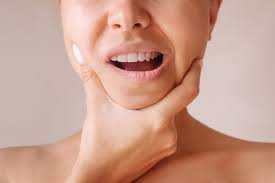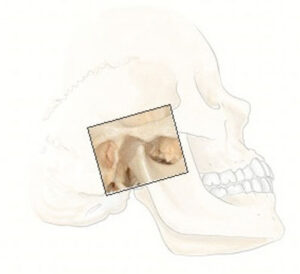

Military neck, also known as cervical kyphosis, occurs when the natural curve of the cervical spine becomes straight or reversed.
This seemingly simple postural issue can have widespread effects on the body, particularly on the jaw.
Jaw stiffness, which often presents as tightness, pain, or limited movement in the jaw joint, is a common but overlooked consequence of poor cervical alignment.
Understanding how military neck posture contributes to jaw stiffness is key to managing both conditions effectively.
Article Index
- What is Military Neck?
- The Structure and Function of the Jaw
- How Military Neck Posture Contributes to Jaw Stiffness
- Common Symptoms of Jaw Stiffness
- How Posture-Related Jaw Issues Are Diagnosed
- Treatment Strategies for Jaw Stiffness Due to Military Neck
- Therapeutic Exercises
- Posture Realignment Techniques
- Medical and Dental Interventions
- Preventive Tips and Lifestyle Changes
- Conclusion
What is Military Neck?
Military neck, or cervical kyphosis, is a condition in which the cervical spine loses its natural C-shaped curve and becomes unnaturally straight.
This posture resembles the stiff, upright stance associated with military personnel—hence the name.
Normally, the cervical spine has a slight inward curve (lordosis) that helps balance the head’s weight and distribute pressure evenly along the spine.
When this curve disappears, it increases the strain on the surrounding muscles, ligaments, and joints.
There are many causes of military neck, including poor ergonomics, prolonged TV screen time, congenital spinal abnormalities, trauma, and degenerative spinal diseases.
Whatever the cause, this postural deviation can disrupt the biomechanics of the head and neck region.
The Structure and Function of the Jaw
The jaw is controlled by the temporomandibular joints (TMJs), which are complex hinge and sliding joints that connect the lower jawbone (mandible) to the temporal bones of the skull.
These joints are essential for performing everyday functions such as chewing, speaking, yawning, and making facial expressions. TMJ function relies on a delicate coordination of muscles, ligaments, discs, and bones.
For example, the articular disc within the joint acts as a cushion to allow smooth movement between the jawbone and skull. Proper jaw mechanics require symmetrical muscle activity and precise structural alignment.
The alignment of the head and neck plays a crucial role in maintaining TMJ health. Poor cervical posture, such as forward head posture, can strain the muscles that link the jaw and neck, like the sternocleidomastoid and masseter.
This imbalance may lead to temporomandibular disorders (TMD), resulting in pain, restricted movement, or joint sounds. (Okeson, 2013; Gauer & Semidey, 2015).
How Military Neck Posture Contributes to Jaw Stiffness?
When the natural curve of the neck flattens, it often leads to a forward head posture. This shifts the head’s center of gravity forward, which overworks the neck and jaw muscles that are trying to keep the head upright.
Over time, this constant strain can lead to muscle fatigue, tension, and joint misalignment in the jaw.
This posture also changes the position of the lower jaw. A forward head posture tends to retract the mandible backward. This backward position alters how the teeth come together (occlusion) and increases stress on the TMJs.
These changes can contribute to restricted jaw movement, inflammation in the joint, and chronic tightness in the surrounding muscles.
Additionally, tension in the neck muscles—especially the sternocleidomastoid and trapezius—can trigger tension in the jaw due to their interconnected fascial and muscular networks. As these muscles tighten, they reduce the jaw’s range of motion and cause stiffness.
Common Symptoms of Jaw Stiffness
Jaw stiffness is a complex condition that can result from more than just muscle tension. It often involves multiple symptoms, which may vary in intensity and duration.
Here is a pointwise explanation of common signs and associated issues:
- Dull Ache or Sharp Pain: This discomfort can be localized around the jaw, ears, or even radiate to the face and neck. It may worsen with jaw use or stress.
- Limited Mouth Opening: Difficulty opening the mouth wide can affect eating, speaking, and oral hygiene, and may indicate joint or muscular restriction.
- Clicking, Popping, or Grinding Sounds: These noises during jaw movement often suggest joint dysfunction, such as disc displacement within the temporomandibular joint (TMJ).
- Pain During Jaw Activity: Actions like chewing, talking, or yawning can become painful, making daily activities challenging.
- Tension Headaches or Migraines: Chronic jaw tension may contribute to headaches due to muscle strain and nerve irritation.
- Neck and Upper Back Stiffness: The jaw is closely linked to the cervical spine; dysfunction can lead to postural imbalances and muscular compensation in these areas.
When left untreated, jaw stiffness can progress into temporomandibular joint disorders (TMD), which may cause chronic pain, worsen symptoms over time, and even alter facial symmetry. Prompt evaluation and care can help manage symptoms effectively and prevent further complications.
How Posture-Related Jaw Issues Are Diagnosed?
Diagnosis of jaw stiffness and related temporomandibular joint (TMJ) issues typically begins with a thorough physical examination, focusing on both posture and jaw mechanics.
A healthcare provider will assess how the head aligns with the spine, looking specifically for signs of forward head posture or straightening of the natural cervical spine curve. These postural imbalances can place added stress on the jaw and surrounding muscles.
The practitioner may palpate (press on) muscles in the neck, shoulders, and jaw to identify areas of tightness, tenderness, or inflammation.
Imaging techniques such as X-rays, MRIs, or CT scans are often used to evaluate the cervical spine’s curvature and the condition of the TMJ itself. These tools help identify joint degeneration, disc displacement, or structural abnormalities.
In some cases, a dental evaluation is also recommended to assess occlusion (bite alignment), as bite imbalances can directly affect jaw function and contribute to stiffness.
A multidisciplinary approach is often the most effective. Collaboration among physical therapists, chiropractors, dentists, and sometimes ENT specialists ensures a well-rounded diagnosis and treatment plan tailored to the individual’s needs, improving outcomes and reducing the risk of chronic issues.
Treatment Strategies for Jaw Stiffness Due to Military Neck
Here are a few ways to approach this:
Therapeutic Exercises:
Corrective exercises aim to restore the cervical spine’s natural curve and relieve muscular tension. Chin tucks are one of the most effective exercises for strengthening deep neck flexors and reversing forward head posture. Other exercises include:
- Wall angels to improve upper back mobility
- Neck stretches targeting the scalene and sternocleidomastoid muscles
- Jaw mobility drills to reduce stiffness and improve range
Regularly practicing these exercises can improve posture and relieve pressure on the TMJs.
Posture Realignment Techniques:
Postural awareness and ergonomic improvements are essential for recovery. Adjusting workstation height, using lumbar support chairs, and keeping screens at eye level can make a significant difference. Mindful posture correction throughout the day prevents muscle fatigue and keeps the spine aligned.
Physical therapists often use manual therapy, myofascial release, and dry needling to release tension in key muscle groups affecting the neck and jaw.
Medical and Dental Interventions:
In moderate to severe cases, additional interventions may be necessary:
- Cervical traction or spinal decompression to reduce pressure on neck discs.
- Bite splints or night guards to reposition the jaw and reduce stress on TMJs.
- Botox injections in the jaw or neck muscles to reduce chronic tension.
- In rare cases, surgical correction of spinal curvature or TMJ surgery may be needed.
All interventions are typically more effective when paired with posture correction.
Preventive Tips and Lifestyle Changes
Preventing jaw stiffness and military neck (a condition where the natural curve of the cervical spine flattens) starts with consistent, proactive daily habits. These small lifestyle changes can have a significant impact on your posture and musculoskeletal health.
- Take regular breaks from screen time: Every 30–45 minutes, stand up, stretch your neck and shoulders, and reset your posture to avoid prolonged forward head position.
- Use supportive pillows: Sleeping with a pillow that maintains the natural curve of your neck helps reduce strain on the cervical spine and jaw muscles.
- Stay hydrated: Proper hydration is essential for maintaining joint lubrication and muscle function.
- Stretch regularly: Incorporate gentle neck and jaw stretches into your daily routine to prevent stiffness and promote flexibility.
- Relax your jaw: Be mindful of jaw clenching during the day. Stress-reduction techniques such as deep breathing or mindfulness can help.
- Engage in posture-friendly exercise: Activities like yoga and Pilates strengthen postural muscles, improve alignment, and reduce tension in the jaw and neck.
By consistently practicing these habits, you can support healthy neck curvature and reduce the risk of developing chronic jaw or spinal issues.
Conclusion
Military neck posture doesn’t just impact your neck—it can create a powerful ripple effect that disrupts the entire jaw system, leading to chronic pain, stiffness, tension headaches, and reduced jaw function.
The intricate connection between cervical spine alignment and temporomandibular joint (TMJ) health means that even subtle changes in posture can trigger significant dysfunction.
When the neck loses its natural curve, it alters the alignment of the head and jaw, causing muscular imbalances and joint strain that often manifest as jaw clenching, clicking, or limited mobility.
Fortunately, this cycle is not irreversible. With early intervention, individuals can significantly improve both neck and jaw health.
Targeted strategies such as corrective neck exercises, ergonomic posture adjustments, stress management, and professional therapies—like physical therapy, chiropractic care, or dental evaluations—can help realign the spine and relieve pressure on the TMJ.
The key is consistency and daily awareness. By committing to better posture and regular self-care, you can restore comfort, function, and long-term balance to your neck and jaw.
References:

